William Crofts and his “Echoes from Wavendon, Woburn Sands, Aspley Guise, Woburn etc.” newspaper
William Crofts was a local printer, born in Woburn in the early 19th century. After a long (but not particularly successful) career in London, he returned to live in Wavendon and produced an amateurish irregular newsletter of his opinions, local scandal and tittle-tattle. A few brief mentions of it in other newspapers are all I had ever seen as no copies were thought to have survived until one surfaced in 2023. This is his lifestory.
The London Printing Business
William Francis Crofts was baptised in Woburn in February 1824, the son of William Crofts snr., a bookseller, and his wife Millicent. In the first census of 1841, ages were generally rounded off, so he is shown as 15 but was actually 17. He is still living at his parents’ house in the High Street, Woburn, with no trade or occupation given for him.
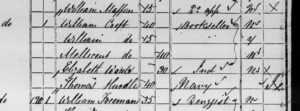
In October 1845, a letter was reprinted in the Beds Mercury which had appeared in the Temperance Weekly Journal. Headed “Friendly Hints to Mr. Wm. Croft junr.”, it’s tone was somewhat less than friendly. William had become a correspondent for the local paper. Mr. Jabez Inwards had taken offence at the way William had reported on two Temperance meetings recently at Aspley and Woburn and gave him five tips for his future writing, including being wholly truthful and not imposing notions of his own into his reports. He goes on to say that if Williams comments persist, he will consider him “Intellectually insane or morally dishonest” – extremely strong words to use for that time. Inwards then adds “If your mental capacities are so weak that you cannot see the absurdity of your conclusion, then you are to be pitied, and every effort should be made for the purpose of developing those powers which will enable you to distinguish betwixt a simple truth and a positive absurdity.”
Inwards also drops the name Green into his attack. It would appear the Croft family had previously been involved in anonymous letter writing scandals as in 1841, when William was only 17, his father was accused of being the writer of letters to the Northamptonshire Herald, under the pen-name of “Jemmy Green”, about certain residents in Woburn, which he denied. Things got so bad that threats were made against him and he went to the Petty Sessions to ask for protection! The real writer was never discovered.
Perhaps having upset too many people, at some point in the next couple of years, he went to London and became a printer. He may have served an apprenticeship with someone his father knew through the book trade. He was married on 6th February 1847 to Anne Elizabeth Strutton of Belgrave Square, at St. George’s church, Hanover Square, when he gave an address of Duke Street, New Oxford Street. His new wife, who was five years his junior, moved in with him there.
Perhaps he had accessed some money through his marriage, but he was managing his own printing firm quite quickly afterwards, as adverts appeared in December 1849 for a new book that he had printed, “Penn Vindicated and Macauley Refuted”, a literary rejection of Macauley’s criticism of William Penn. This was advertised in The Examiner for 9d. or free for 12 postage stamps. No.10 Duke Street was given as Crofts’ address, so it was likely he was working from his home. Another book came out at about the same time, January 1850, advertised in the Lady’s Newspaper and Pictorial Times, called “Wanted! A Wife!”, a cautionary tale of a young man who goes to London and is seduced by city life and therefore misses the chance of marrying his friend’s sister. (1s. or free for 14 stamps.) No author was given for either of these books.
More publications soon followed. In June 1850, “The High Priest’s Dress or Christ Arrayed in Aaron’s Robes” and “The Earth’s Renewal”, both by Rev. D. F. Jarman, minister of the Bedford Episcopal Chapel in Bloomsbury appeared. Then, anonymously written by a member of the Catholic Church, “Jews in Parliament” was published in September.
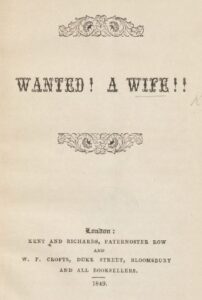
They were still at the no.10 Duke Street, just south of Piccadilly, at the census of 1851, with William described as a “General Printer”. By this time, they had had two children, Frederick, 2, and Eliza, 10 months. They shared their household with a 20-year-old compositor, Thomas Hudson Strong (no doubt employed by William) and two lodgers.
Business must have been good and he soon needed to expand. He took on new premises and posted adverts in the May 1857 Morning Advertiser for posts as lithographic writers, engravers, pressmen and a youth experienced in working a printing case at his printworks, at no.63 Castle Street East, now known as East Castle Street, which runs parallel to Oxford Street, just to the north.
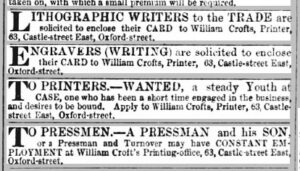
This was followed six months later by a series of adverts in the Morning Herald from 11th November 1857:
“Printing, at prices to meet the times, at 63, Castle-street East, Oxford-street, by WILLIAM CROFTS. Invoices, Bill-heads, Cards, Circulars, Handbills, Posters, Lithographed Letters, &c. Envelopes supplied, addressed, and circulars enclosed, at agreed prices.”
More detailed adverts for his business were run in the Reynolds’s Newspaper from January 1858. He had by then opened a retail shop at no.49a Castle Street, Oxford Street, keeping no.63 as his main printing office. From May, he advertised a new retail venture, selling his own range of accounts, ledger and cash books and “Croft’s Half-Crown Stationery Packets”, which contained:
“Two quires of best cream laid notepaper – Two packets of envelopes to match – half-dozen Steel Pens with cedar holders – Bottle of Ink – Sheet of Blotting-paper – Stick of Sealing wax – Box of Wafers – Cedar Pencil, and Patent Pencil Cutter – Bottle of Marking Ink and Quill Pen – Two Memorandums and Two India Rubber Bands, delivered free within five miles…”
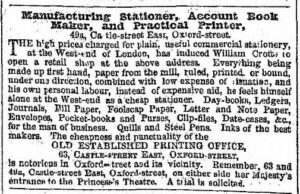
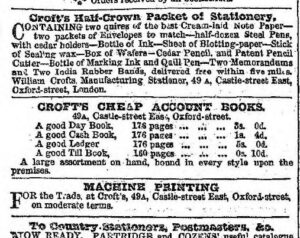
He also advertised in the Marylebone Mercury, saying he was a Letter Press, Copper Plate and Lithographic Printer and that: “Low expense of situation, our own manufactured goods and personal labour, enable us to sell cheap, and we do so.”
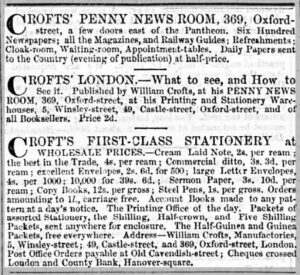
From November 1859, he advertised another expansion to his business in the London Weekly Mail. He had now opened a Penny News Room at no.369 Oxford Street with 600 publications available, including his own new venture, “Croft’s London – what to see and how to see it”, an early guidebook to the capital. It’s a fascinating look at what was popular in London at that time, with some sage advice for avoiding some of the more common problems with swindlers and conmen! How much was gleaned from his own early experiences in London is not known. Of course, it gives regular plugs for William’s own Reading Room and stationery supplies, but also features an advert for his family’s new business back home in Woburn, “The Farmers Friend”. The selection of pages reproduced below come from the British Library’s copy.
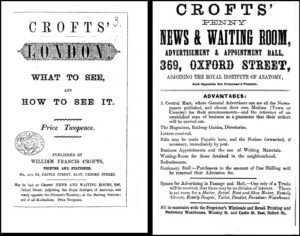
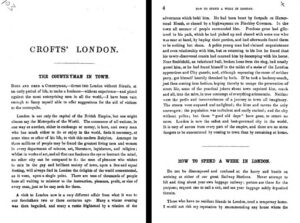
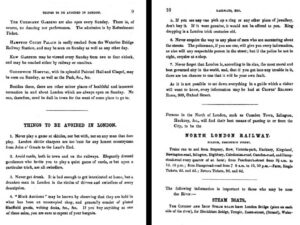
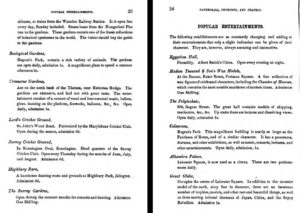
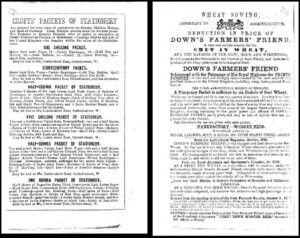
[You can see the whole book here for free: Crofts’ London; what to See, and how to See it by William Francis Crofts – Books on Google Play ]
Adverts for all his businesses continued into 1860, adding in another new outlet at no.5 Winsley Street, again just north of Oxford Street. But his printing, publishing and library endeavours all came crashing down when he was declared bankrupt in September 1860 – the rapid enlargement of his printing empire had failed. This started a decade-long series of notifications in the London Gazette, beginning 14th September, which seems to indicate he was declared bankrupt not once or twice, but possibly four times.
“Whereas a Petition for adjudication of Bankruptcy was, on the 12th day of September, 1860, filed against William Francis Crofts, of Nos. 49a and 63 Castle-street East, Oxford-street, in the county of Middlesex, printer, and he having been declared bankrupt, is hereby required to surrender himself to Edward Goulburn, Serjeant-at-Law, one of Her Majesty’s Commissioners of the Court of Bankruptcy, on the first day of October next, at twelve of the clock at noon precisely, and on the 29th day of October next at two of the clock in the afternoon precisely at the Court of Bankruptcy, Basinghall-street, in the city of London and make a full discovery and disclosure of his estate and effects; when and where the creditors are to come prepared to prove their debts, and at the first sitting to choose assignees, and at the last sitting the said bankrupt is required to finish his examination. All person indebted to the said bankrupt, or to have any of his effects, are not to pay or deliver the same but to Mr. Pennell, No.3 Guildhall-chambers, Basinghall-street London, the official Assignee in the matter of this Bankruptcy and give notice to Mr. G. E. Kays, solicitor, No.89 Chancery-lane, London”
The examination found the following:
Debts:
To creditors £2,691 6s. 1d.
To creditors holding security £60 1s. 9d.
To liabilities £ 398 9s. 9d.
Total £3149 17s. 7d.
Credits:
By debtors, would be paid £ 124 5s. 3d.
By debtors, might be paid £ 59 9s. 3d.
By debtors, won’t be paid £197 2s. 11d.
By property £ 500 0s. 0d.
By property held by creditors £ 65 0s. 0d.
Total £945 17s. 4d.
On 21st December, the Court suspended his bankruptcy Certificate for twelve months and issued a Third-Class Certificate – a bankruptcy that was attributable wholly to causes other than misfortune or accident. A dividend for his creditors was signed off in May – ordering that he pay 1s. 9d. to them for every £1 he owed.
The next census of 1861 shows the family had moved to no.24a, Hawley Road, St. Pancras, showing a third child, daughter Millicent (born 1853) and (bizarrely given his reduced circumstances) they still had a servant, Sarah Staples. William’s occupation was entered as “Printer – out of business”.
Back in Woburn, his mother and father were still living in Bedford Street, but William snr’s. trade had changed from “Bookseller” in 1841 to “Manufacturer of a chemical preparation known as Farmers Friend”, as advertised in Crofts’ London. Next door to William snr. lived his daughter, Emma Down (William’s sister) and her family. She was a widow with two daughters still living with her, two sons having already moved out. She had married a local chemist, Henry Down, in December 1839, who had originally produced the agricultural chemical. He died just ten years into the marriage, but his two sons went on to create a large business empire in Woburn Sands. It seems likely it was a Down family invention that William Crofts snr. had ended up running as his son-in-law had died so young. There was a great deal of animosity later between William Crofts and one of Down’s sons, his nephew.
Williams’ 13-year-old son Frederick went to Woburn to stay with his grandfather, William snr. Unfortunately, Frederick was taken ill whilst there and died after a few days’ illness on 11th July 1861. William was described as being of Kentish Town in the Beds. Times Deaths notice for his son.
Now living at 74 Mortimer Street Cavendish Square, the Bankruptcy Court noted that he had entered into a Deed of Assignment with his father, William snr., in March 1863, so it seems his family had come to the rescue and bailed him out. They promised to pay remaining debtors 4s. in the £ by the end of the month. Whether or not that happened, I do not know, but in 1864, after moving several times around London, he was bankrupted again. The London Gazette, November 8th:
“William Francis Crofts, formerly carrying on business at no.74 Mortimer-street, Cavendish-square, Printer, Stationer and Advertising Agent, and then residing at No.24 Hawley-road, Kentish Town…now of Denmark-street, Camberwell… Commission Agent and now residing at No.1 East Lane, Bermondsey… Commercial Clerk, is hereby required to surrender…”
Almost exactly the same notice appeared again in November 1864, from which he was discharged in January 1865, still living at East Lane, Bermondsey. Another Deed of Assignment between him and his creidtors was signed in October 1867, but this time there was no sign of help from his father. Perhaps he had refused to help. This time he promised 2s. 6d. on every £ he owed by the end of January 1868, but again, it wasn’t the end of his problems. In May 1869, time and money had run out for William.
“William Francis Crofts, of No. 229, Camberwell-road and Grove-lane, Camberwell, formerly of Denmark-street, Camberwell, all the county of Surrey, Printer, a Prisoner for Debt in the Debtors Prison for London and Middlesex, having been adjudged bankrupt under a Petition for adjudication of Bankrupcy (in form pauperis) filed in Her Majesty’s Court of Bankruptcy, in London, on the 21st of May 1869, is hereby required to surrender himself to Philip Henry Pepys, Esq…”
He then seems to have given up trying to run his own business and started working for others. By the next census of 1871, he is described as a “Printer’s Traveller”. The family had moved again to no.16 Mayrick Road, Battersea. Both their daughters were still living at home, the eldest Eliza described as a “shopwoman”. There was also a boarder in their house and they no longer had their servant.
Yet even when working for someone else, money problems seemed to follow him. He worked as a travelling salesman for Bentley & Botten, who had cause to sue a Clapham auctioneer, Mr. Stevens, over an unpaid bill of £14 16s. for printing posters and auction bills. Crofts had taken the order from Stevens on behalf of the firm, but Stevens thought Crofts was supplying him directly and did not know Bentley & Botten were the suppliers. Crofts had since left the employ of the firm and Stevens refused to pay Bentley & Botten for the goods. Stevens had used Crofts previously when he had his own printing firm and Crofts had owed him money which he expected to be deducted from this printing bill, which, of course, Bentley & Botten were not prepared to entertain. The Auctioneer was ordered to pay the bill. (London City Press, 12th August 1871)
I found a small personal ad for a printer in West Street, Harrow by the name of Crofts, in December 1871, appealing for a boy to help in the business. Did he try to start up again? If he did, no more adverts appear from him or notices about him in the online newspapers currently available. There is a seven-year gap until he appears again.
Back to the Villages
1878 is the earliest mention of his living back in this district, in Wavendon, now 54. A small advert in Croydon’s Weekly Standard, published in Newport Pagnell, on 5th October, announced:
“Literary Institute, Woburn Sands. Mr. William Crofts (of Wavendon) has the pleasure to announce that he will give a course of Readings at the above Institute commencing, Wednesday evening, October 16, 1878. Programmes will be immediately issued.”
Similar adverts appeared in the Leighton Buzzard Observer (LBO) specifying that there would be three readings. The LBO had a detailed advert for the second reading, showing the entertainment would include “The Persecution of George Bunger”, “Horatius” and “Nell Cook”. Music was provided by the Wavendon School Drum & Fife Band and a proportion of the proceeds raised would be given to the Woburn Sands and Wavendon National Schools. Tickets were 1s., 6d or 3d. The Literary Institute in Woburn Sands had been opened four years before, funded by voluntary subscription. The LBO reviewed the series of readings in its 5th November edition:
“Literary Institute. The readings by Mr. William Crofts (of Wavendon) have terminated – at least, the first series, which it is hoped will not be the last. The audience on the 23rd inst. was agreeably numerous and highly intelligent, if not crowded. The pieces read were “The story of the Goblin who stole a Sexton” (Pickwick), Lord Macaulay’s “Horatius” and, from Ingoldsby, “Nell Cook,” &c., with one or two short pieces from Eliza Cook’s poems. Mr. Clark, of Woburn, accompanied by his talented sister, sang the “Death of Nelson” and the “Englishman” very effectively, and Miss King, of Walton, introduced several pretty ballads and pianoforte variations, which, with the Drum and Fife Band from Wavendon, lent a pleasant relief to the evening’s entertainment. On Wednesday, the 30th, the evening was far from a tempting one to leave home, owing to the effects on the roads of the heavy morning fall of snow. The “Madman’s manuscript” (Pickwick), and “Spanish Armada” (Macaulay), selections from Ingoldsby, by Eliza Cook, &c., formed the readings. Mr. Crofts was happy in the assistance of Miss Morris, of Holcot, who brilliantly performed several pieces on the pianoforte. Miss King again gave her well-appreciated assistance, and two young ladies made their first appearance – Miss Luttman and Miss Handscombe, playing with great credit and skill “The Marseille” and the “Post-horn Quadrilles”. On the second evening there were parties from Woburn, Aspley, and the neighbourhood, and the general impression made was that Mr. Crofts proved himself a distinct and effective reader. The Rev. Mr. Burney of Wavendon; Mr. Swabey, of Aspley; C. Pole Stuart, esq., Sandydown House, Woburn Sands, and party; besides a goodly number of friends from Wavendon etc. were present. The platform was literally strewn with all flowers of this late season, presented by neighbours and tastefully arranged. Mr. Crofts may at least be gratified at his reception; proud of the superior talent of the ladies who assisted him and of the intelligence of his audience.”
Woburn Sands was not the only village to enjoy Crofts’ performances. In November, he went to an entertainment at Toddington National School and read from Tom Hood’s “Bachelor’s Dream”, “…with success, if creating laughter means success; on mounting the platform for his second piece, ‘Rural felicity’ (also Tom Hood’s), he was met with a burst of applause…”
William had a hand in the publishing of “The Climate & Topography of Aspley Guise” by Dr. James Williams. He was soliciting for subscribers and local advertisements to put in it before it went to press in November 1878. The book gave Aspley Guise and Aspley Heath a spa-like reputation for being good for health and wealthy Victorians flocked to the area, buying up small properties and erecting large mansions on the strength of his recommendation.
Despite the LBO saying the series of readings in Woburn Sands was over, another took place on December 9th, 1878, in the Wavendon National Schoolroom. This one, according to the advert in Croydon’s Weekly Standard, featured selections by William from “Sam Slick”, Tom Hood’s “Up the Rhine”, “Martha Penny in Becky Page” and numerous tales and stories from Pickwick. He was part of a range of performers that night. The LBO review said he had produced “…uproarious fun…” but the audience had not been so crowded as previous events and they blamed the 2s. or 1s. admission prices!
His New Year of 1879 started with a performance of some comic pieces on New Year’s Day at the annual dinner for the inmates of Woburn Workhouse, according to the Northampton Mercury. The Duke of Bedford and family came during the day to visit the sick wards. The evening was spent in the company of the workhouse inmates and Guardians, singing songs and enjoying the treats taken from the Christmas tree.
A letter appeared soon after in the Bedford Record, mentioning the Duke’s visit to the workhouse infirmary and other recent public speeches he had made. It was particularly sarcastic, complaining that the Duke of Bedford should do more to help with the agricultural distress the county (and country) found itself in at that time. It was one of a series of attacks in the press which had been signed-of as from a “John Commoner”. The Bedford Record said they had received so much interest in the letters that they would publish them as a book. They also published a denial that it was William Crofts who had written them. Beds Record 18th January 1879: “We are requested to say – if such need be said – that Mr. William Crofts, of Wavendon, is not the writer of “Letters to a Duke”.” Some people obviously thought it was! The book was indeed published in March with 12 chapters attacking the Duke on a number of topics. The British Library holds a copy, which entry it states was actually written by a Gordon Graham Flaws.
William acted as jurist at an inquest for Alice Horton, 18, who had died suddenly after pains in her side, in January 1879. The inquest was held at the Swan Inn, Woburn Sands, which was then owned by Frederick Down, William’s nephew, who had become a prosperous businessman in partnership with his elder brother, Henry. Having made their fortune with “The Farmers Friend” chemical, they had branched out into having a malting at Woburn Sands, several pubs and a soft-drinks factory. Both jurors and landlord gave their fees to the poor girl’s family.
It does not seem that William had retired from London to the country for a quiet life of public readings as adverts for his new local businesses began to appear in February 1879. The first was a small ad in the LBO for a useful (but aged) Carriage Horse, to suit a carrier (£16) and a tradesman’s horse (£12 10s.) Interested parties were advised to apply at his office near the station. In March, he had another, “A girl (aged 17), well connected and of pleasing and agreeable manners, is anxious for a situation to attend a little boy or girl, and to fill up her time at Needlework. Recommendations unquestionable. Apply by letter to William Crofts’ office near the Station Woburn Sands.” He wasn’t dealing in horses (or young girls…) but merely acting as a business agent for others. In April, a full ad for his seven basic services appeared in the Luton Times:
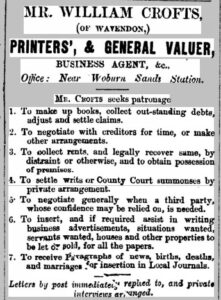
…to which the following section was added from the next month:
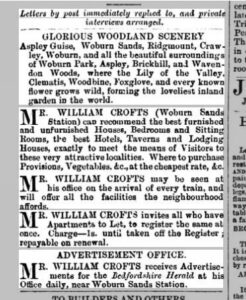
As such a jack-of-all-trades, he attracted quite a variety of tasks. The following three ads are all from the Luton Times. Where exactly his office was, near the station, I do not know.
20th June 1879:- “Dogs for sale. A handsome well-bred colley, Dog and Bitch, rich tan, well coated, good heads and brush. Dog, 7 months old; Bitch 12 months Price 21s each Apply to William Crofts office, Woburn Sands”
27th June 1879:- “To Be Let, furnished, a Genteel House at Woburn Sands, has three bedrooms, good sitting-room and appointments – Write to William Crofts Woburn Sands”
3rd October 1879:- “Garden Ground on Aspley Heath. 60 poles of land on Aspley Heath TO BE LET in one lot from September 29th inst. It is well fenced. Rent £2 per annum. Apply to William Crofts, near Woburn Sands station”
It is perhaps surprising that he chose to advertise in a newspaper at some distance away when there were several others closer, but it appears they had a fairly low opinion of him. He had begun to publish his own little newsletter about local events and personalities, which he called “Echoes from Woburn, Woburn Sands, Wavendon, and surroundings” which seems to have annoyed some of the local newspapers… The North Bucks Times, 16th October 1879:
“The Fair. On Saturday last the annual pleasure fair was held at Fenny Stratford. There were the usual number of stalls, knock ‘em downs, and &c., and the visitors towards evening were as numerous as in former years. The writer arrived in the afternoon, and by the same train he observed an old acquaintance formerly if not at present connected with the local press, with a package under his arm containing two or three dozen of what was thought to be old newspapers. Later on the bundle of newspapers was explained in a most peculiar manner. Surrounded by a few ragged children we saw a man hurrying along, wearing a seedy coat buttoned over a very dirty white apron – the very personification of a “snob.” Upon after inquiry we found he was a shoemaker by trade, but holding the honourable office of parish paperhanger and town crier. This individual made a precipitate halt, and as nearly as possible the following was the result; Tingle, tingle, tingle, – the sound of a small bell, which resembled very much such a one as might have been taken from the neck of some old bellwether sheep. The voice from the man in the dirty white apron then proclaimed as follows; “Oyez! Oyez!! Oyez!!! This is to give notice that Colonel Drury-Lowe has just returned from Zulu-land. A full account of the demonstration at Woburn Sands will be found in the Bedfordshire ‘Official’ Journal which may be purchased at my house, price one penny. God Save the Queen,” and the man in the dirty-white apron passed on, amid the wonder of his juvenile auditors. We invested a penny, and purchased an “official” from Mr. William Crofts, of Wavendon, the compiler of “Echoes from Woburn, Woburn Sands, Wavendon, and surroundings” a copy of which, by the bye, was enclosed in the “official” and which is in every way unique, [italicised] and abounds in sly hits and innuendos on the character and profession of several gentlemen, nearly all the respectable tradesmen and inhabitants of the neighbourhood, with extracts from the Record and other newspapers. Mr. William Crofts, however, had an eye to business of a more high and lucrative standing when he was vending the “official” paper, which, although it is an advertisement, we publish gratuitously for his benefit, which was also included in our penny purchase: “Mr. Crofts seeks patronage to make up books; collect outstanding debts, adjust and settle claims; to negotiate with creditors for time, or make other arrangements; to collect rents, and legally recover same, by distraint or otherwise, and to obtain position of premises; to settle writs or county court summonses by private arrangements, to negotiate generally when a third party, whose confidence may be relied on, is needed.” The last we saw of Mr. Crofts was his making his way back to the railway station with a bundle of the “official” journals under his arm, and we regret to say that the cry of the crier in the dirty white apron was a fib and a falsehood, and a catch penny invented by Mr. William Crofts, who seeks patronage, and that the demonstration on the return of Colonel Drury-Lowe to Woburn Sands has not yet taken place.”
“Sly hits and innuendos…” and “a fib and a falsehood…” were quite serious accusations for the time – people ended up in court for far less – but nothing seems to have come of it. Many people would have remembered William’s short and unsuccessful journalistic career from before he went to London. In December 1879, Croydon’s Weekly Standard ran a small advert that issue no.4 of “Echoes…” was now ready, into which title William had also now crammed Toddington and Fenny Stratford. This is the only time I can find it so advertised in another paper.

William was in Court the next year, but it was only to represent an aggrieved baker. The Northampton Mercury 19th June 1880: “Joseph Souster v. John Shepherd. Mr. W. F. Crofts, of Wavendon, for the plaintiff, a baker, of Northampton; The defendant being a labourer at Bow Brickhill. Claim 19s. 4d. Defendant admitted his liability for 15s.11d. for which amount his Honour gave judgement”.
The North Bucks Times, who had poured scorn on William in October 1879, were happy to take his adverts for his business in December 1880, although there was no mention of his own newspaper. His address was now listed as Manor Farm Cottage, Wavendon.
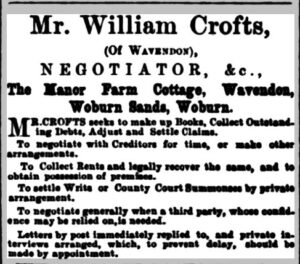
William’s writing was getting him in to trouble still. The North Bucks Times decided to distance themselves from him in March 1881: “Notice. Having heard that an impression exists that Mr. W. Crofts, of Wavendon, is a representative of the “Fenny Stratford Weekly Times,” we beg to state that we have no connection whatever with that gentleman, and that he does not in any way represent us.”
I cannot find which, if any, local newspaper he was providing local news to, as authors of these pieces are not generally given. Yet he was certainly reporting for a newspaper somewhere. Another census occurred in 1881. William and his wife appear four households away from the Leathern Bottel Inn under Wavendon (if that is any indication of where the house actually stood – it may not be.) He is described in it as a “Newspaper Reporter Correspondent”.
His next appearance in the press was not as a writer but as defendant, but sadly we don’t get to find out to exactly why, as this is the only reference to the event. From the Bucks Herald, 22nd April 1882: “Newport Pagnell. Petty Sessions. Mr. W. E. Clark, of Fenny Stratford, applied for sureties of peace against William Crofts, of Wavendon, in consequence of threats which Mr. Crofts had used against him. Mr. S. Smith, of Fenny Stratford, appeared for Mr. Clark. After hearing the evidence, the bench dismissed the application.”
After the flurry of articles containing his name over the last few years, things start to slow down. He was now in his late 50s. In April 1884, he found a local man lying in the road, having been taken ill, who had been ignored by other passers-by for four hours as they thought he was drunk. George Chance was 65 and well known in the area for his fiddle playing. He never recovered and died a couple of weeks later.
William’s daughter Eliza was married back in London at Marylebone on 25th February 1885, to Samuel E. Pallant of Halkin Street West, Belgravia. The same month, issue no.7 of “Echoes” was published. Knowing that issue no.4 had been in December 1879, it doesn’t seem to have been a very regular publication! This example is undated, but references some letters written in 1884 and the lead article is an attack on Frederick Down who had stood for election, unsuccessfully, as Parish Surveyor for Wavendon, which happened in February 1885. It is a single sheet of paper, about A3, folded for four A4-ish pages. The first article runs thus:
“It is the Cause, I say, It is the Cause! AND SO here stands a Post. The election of surveyors for the parish of Wavendon is over, and the old officials retained their positions. The result being for Gadsden 175, Sturgis 161, and Down 124. Every effort had been made by the Woburn Sands party to obtain a candidate possessed of at least one inherent quality, that of a gentleman, as well as the practical experience necessary for the appointment. In the post they stuck up, Mr Frederic William Down, they had neither, but on the contrary the most unpopular young man in the parish. Supercilious, dogmatical, overbearing, a presuming boy, ignorantly haughty, and “crammed with arrogancy spleen and pride.”
How was it then he scored so many votes and was beaten by the second successful candidate by only 37 votes. Because the Woburn Sands people, justly or unjustly complain of the roads being imperfectly done, and have resolved to be represented on that side the parish. It is maintained that an extra rate of 3d. in the £ would do all that is required, and that the present surveyors, who are farmers, will not do this, because it would touch their pockets to the extent of 30/ or 40/ extra in the year.
At the present time it is stated that 2/3 of the rates are payable from the Washington side of the station gates, and that up to last year two-thirds of the monies collected were expended upon the Woburn Sands roads. The whole of the Wavendon ratepayers may be thankful at the result of the election so far as Mr. Down’s defeat is concerned: it may remind them of the fable of “The Frogs desiring a King”. Jupiter first gave them one, not contented with it, they applied again, and he sent them a Stork, and without every any ceremony it fell devouring and eating them up, as fast as he could. Frederick William would have eaten them up, so sure as fate. The mimic Caesar, would have seized them and no mistake. But there is no doubt Woburn Sands will soon have its own surveyors and parochial officers. There is hardly a chance of there being another contest with Wavendon proper. The command had gone forth from the Local Government Board that Aspley Heath is to immediately choose its Guardian who will for the time being be accredited to the Woburn Union. That a further inquiry is pending as to forming Woburn Sands portion of Wavendon into a district and perhaps amalgamating it with Aspley Heath, then it will be decided which Union they will form a part of, Woburn or Newport Pagnell.”
Frederick Down was the son of William’s own sister – his nephew! And this “presuming boy” was 37. Relations within the family must have broken down somewhat since the days of William advertising their “Farmers Friend” chemical business in his London guidebook in 1859.
The rest of this edition of “Echoes” is filled with similar gossip-mongering and scornful satire aimed at local institutions and people. The Fenny Stratford churchwardens, Woburn Sands Institute, the drinkers of Aspley Guise and a robbery at Wavendon church are all discussed in snide terms. A complaint letter sent in about something William had allegedly said to a third-party about Mr. Miller, the other printer of Woburn Sands, was reproduced in full, as was William’s denial of saying it.
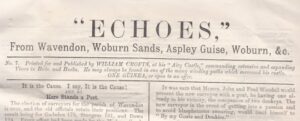
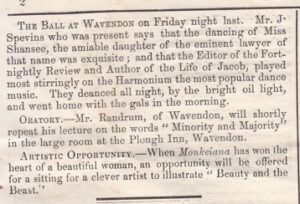
Much of it is written with actual names disguised, so we may never know the targets of his wit…
William was still giving performances at readings. The Bucks Advertiser 11th April 1885: “Wavendon. Readings. Mr. Crofts, of this village, gave, on Tuesday evening, with success, readings from the more humorous selections of Tom Hood, Haynes Bailey, &c. His patrons were the most distinguished families of the district. He was ably assisted by Miss Crane, of Woburn Sands, who presided at the pianoforte and played with charming execution some popular pieces. Her father was well received in the popular song “The Stirrup Cup,” and Mr. John Clark, of Woburn Sands, sang, with happy conception, Hood’s “Faithless Nelly Grey.” The evening’s entertainment closed with Macaulay’s “Armada” and “Rule Britannia,” by Miss Crane, Tom Hood’s stanzas “With the good of our Country before us,” and “God Save the Queen,” joined in by the audience.”
In February 1887, Wavendon had been made to contribute to funding Aspley Heath School via their rates and were therefore entitled to select two representatives for the School Board. Five residents put their names forward for the two vacant positions and a meeting was arranged to sort out who would stand and who would withdraw, so that there would be no need for the £20-30 expense of a full election. William had been one of those who said he would stand, but then refused to attend this meeting and his absence was “generally and severely commented on.” This was considered “very undignified and scarcely courteous towards the ratepayers” by the report in the North Bucks Times. The meeting decided to select two from the four who had attended and it was noted that William had retired from the contest the next day.
The landlord of the Plough Inn, Wavendon, John Gregory, was called as a witness at a Newport Pagnell Petty Sessions court case in October 1887 about an argument that developed into a physical altercation in his pub in September. The Croydon’s Weekly Standard had almost a full column of details, which seems to be a disagreement over insulted dignities, which resulted in Joseph Crawley hitting William for something he had said. William was there to pay money into the Oddfellows Society. Crawley said William owed him 3s., but William believed Crawley had previously insulted him in the Station Hotel, calling his a “bloody sot” and he would not pay the bill until Crawley issued a summons. Things got heated and when Crawley punched William, it knocked some of his teeth out. Crawley was eventually fined 2s. 6d. with £2. 12s. costs or 14 days.
William’s work as an agent assisting others with their newspaper adverts continued sporadically. The Northampton Mercury 22nd September 1888: “Wanted, a general servant in a small Country Hotel, good tempered, with good appearance and pleasing manners; used to children; able to wait at table, or willing to be taught; Over 20. A very comfortable home for one of good character. Apply with references to Mr. Crofts, Ivy Cottage Wavendon, Woburn, Beds.” and Northants Chronicle on 9th January 1889: “To be sold, Horse, Wagonette, and Harness, together or separate, the property of a lady leaving the neighbourhood. May be viewed, by appointment, with Mr. Crofts, Ivy Lodge, Wavendon, Woburn, Beds.”
The last census to feature William was the 1891. He was still living at Ivy Cottage, Walton Road, Church End, Wavendon. The house has now been cleared away, but stood by the entrance gates to Wavendon Tower. He is again described as a “Newspaper Report Correspondent”.
William Crofts died in 1892, aged 69. This brief obituary appeared in the Beds. Times on 27th February:
“Wavendon. Death of Mr. W. Crofts – By the death of Mr. William Crofts which occurred at Wavendon last week a familiar figure will be much missed in the district. The deceased was well known as a correspondent to several local newspapers, and it was very rarely his face was missed from the principal events of the neighbourhood. His funeral took place at Wavendon Church on Saturday.”
Annie Crofts appears in the 1901 census in an entry in Wavendon immediately following the one for Wavendon Tower, listed as just Walton Road. She was then 73, described as “Living on own Means”. Their unmarried daughter Millicent, 48, had moved in with her, described as a “Governess (retired) School”. Annie survived William by just over a decade and her passing was also referenced by the Beds. Times, on 15th May 1903:
“It is with regret that we record the death of one of the oldest inhabitants of this village in the person of Mrs. Crofts, which occurred on Saturday. Deceased was the widow of the late Mr. William Crofts, who was well known throughout the whole county in the journalistic world. She was 75 years old, and had had a long and extremely painful illness, which was born patiently to the end. She was highly respected and leaves two daughters to mourn her loss.”
Millicent stayed on in Ivy Cottage alone until at least 1931 but appears to have moved away from Wavendon before her death. She gets a brief mention in the photo book “Wavendon as it Was”, saying she had been in service with the Russian and Greek Royal families during her career. After she died, her house was demolished in 1939 when this appeared in the Leighton Buzzard Observer, 21st March:
“WAVENDON – A LOVELY OLD COTTAGE – OWNER’S SERVICE TO RUSSIAN ROYAL FAMILY. A beautiful old cottage in Walton Lane is being demolished in the course of road widening. The cottage stood at a narrow corner and it is realized that for modern traffic the road will be greatly improved at this point. All the same, the older inhabitants regret its passing, for many village homes were made brighter with flowers from its old-world garden in the spring and summer. Miss Croft, who had lived alone in the cottage since the death of her parents many years ago, sold flowers and fruit during the season. Although more than 80 years of age, she has left the village to reside at Old Coulsdon. Before coming here to look after her parents about 47 years ago, Miss Croft was a nurse to Princess Helen of Greece, the mother of the Duchess of Kent, who was then a Russian Grand Duchess, and was well acquainted with members of the Russian Imperial family. She treasured their photographs, and their children had visited her since she came to live in the village. Miss Croft was a guest of Princess Marina of Greece at her marriage to the Duke of Kent.”
Over many years researching Woburn Sands, I had seen one or two references to the “Echoes” newspaper but there are no surviving copies lodged in any archive or library. One was found in some family history papers locally in May 2023 and generously donated to me.
Page last updated November 2023.
